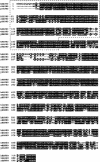Expression of a unique drug-resistant Hsp90 ortholog by the nematode Caenorhabditis elegans
- PMID: 12820659
- PMCID: PMC514859
- DOI: 10.1379/1466-1268(2003)8<93:eoaudh>2.0.co;2
Expression of a unique drug-resistant Hsp90 ortholog by the nematode Caenorhabditis elegans
Abstract
In all species studied to date, the function of heat shock protein 90 (Hsp90), a ubiquitous and evolutionarily conserved molecular chaperone, is inhibited selectively by the natural product drugs geldanamycin (GA) and radicicol. Crystal structures of the N-terminal region of yeast and human Hsp90 have revealed that these compounds interact with the chaperone in a Bergerat-type adenine nucleotide-binding fold shared throughout the gyrase, Hsp90, histidine kinase mutL (GHKL) superfamily of adenosine triphosphatases. To better understand the consequences of disrupting Hsp90 function in a genetically tractable multicellular organism, we exposed the soil-dwelling nematode Caenorhabditis elegans to GA under a variety of conditions designed to optimize drug uptake. Mutations in the gene encoding C elegans Hsp90 affect larval viability, dauer development, fertility, and life span. However, exposure of worms to GA produced no discernable phenotypes, although the amino acid sequence of worm Hsp90 is 85% homologous to that of human Hsp90. Consistent with this observation, we found that solid phase-immobilized GA failed to bind worm Hsp90 from worm protein extracts or when translated in a rabbit reticulocyte lysate system. Further, affinity precipitation studies using chimeric worm-vertebrate fusion proteins or worm C-terminal truncations expressed in reticulocyte lysate revealed that the conserved nucleotide-binding fold of worm Hsp90 exhibits the novel ability to bind adenosine triphosphate but not GA. Despite its unusual GA resistance, worm Hsp90 appeared fully functional when expressed in a vertebrate background. It heterodimerized with its vertebrate counterpart and showed no evidence of compromising its essential cellular functions. Heterologous expression of worm Hsp90 in tumor cells, however, did not render them GA resistant. These findings provide new insights into the nature of unusual N-terminal nucleotide-binding fold of Hsp90 and suggest that target-related drug resistance is unlikely to emerge in patients receiving GA-like chemotherapeutic agents.
Figures






Similar articles
-
Hsp90 is essential in the filarial nematode Brugia pahangi.Int J Parasitol. 2005 May;35(6):627-36. doi: 10.1016/j.ijpara.2005.01.007. Epub 2005 Mar 19. Int J Parasitol. 2005. PMID: 15862576
-
Effect of geldanamycin on the kinetics of chaperone-mediated renaturation of firefly luciferase in rabbit reticulocyte lysate.Biochemistry. 1996 Oct 15;35(41):13443-50. doi: 10.1021/bi9615396. Biochemistry. 1996. PMID: 8873613
-
A novel chaperone-activity-reducing mechanism of the 90-kDa molecular chaperone HSP90.Biochem J. 1999 Nov 1;343 Pt 3(Pt 3):697-703. Biochem J. 1999. PMID: 10527951 Free PMC article.
-
Spotlight on the microbes that produce heat shock protein 90-targeting antibiotics.Open Biol. 2012 Dec 12;2(12):120138. doi: 10.1098/rsob.120138. Open Biol. 2012. PMID: 23271830 Free PMC article. Review.
-
Hydrating for resistance to radicicol.ACS Chem Biol. 2009 Apr 17;4(4):245-7. doi: 10.1021/cb9000712. ACS Chem Biol. 2009. PMID: 19371133 Free PMC article. Review.
Cited by
-
A rhizosphere fungus enhances Arabidopsis thermotolerance through production of an HSP90 inhibitor.Plant Physiol. 2007 Sep;145(1):174-82. doi: 10.1104/pp.107.101808. Epub 2007 Jul 13. Plant Physiol. 2007. PMID: 17631526 Free PMC article.
-
Assay strategies for the discovery and validation of therapeutics targeting Brugia pahangi Hsp90.PLoS Negl Trop Dis. 2010 Jun 15;4(6):e714. doi: 10.1371/journal.pntd.0000714. PLoS Negl Trop Dis. 2010. PMID: 20559560 Free PMC article.
-
Heat shock protein 90 as a drug target against protozoan infections: biochemical characterization of HSP90 from Plasmodium falciparum and Trypanosoma evansi and evaluation of its inhibitor as a candidate drug.J Biol Chem. 2010 Dec 3;285(49):37964-75. doi: 10.1074/jbc.M110.155317. Epub 2010 Sep 13. J Biol Chem. 2010. PMID: 20837488 Free PMC article.
-
Anti-malarial activity of geldanamycin derivatives in mice infected with Plasmodium yoelii.Malar J. 2012 Feb 23;11:54. doi: 10.1186/1475-2875-11-54. Malar J. 2012. PMID: 22361388 Free PMC article.
-
Transcriptomics-Based Screening Identifies Pharmacological Inhibition of Hsp90 as a Means to Defer Aging.Cell Rep. 2019 Apr 9;27(2):467-480.e6. doi: 10.1016/j.celrep.2019.03.044. Cell Rep. 2019. PMID: 30970250 Free PMC article.
References
-
- Amzel LM. Structure-based drug design. Curr Opin Biotechnol. 1998;9:366–369. - PubMed
-
- Bagatell R, Khan O, Paine-Murrieta G, Taylor CW, Akinaga S, Whitesell L. Destabilization of steroid receptors by Hsp90-binding drugs: a ligand independent approach to hormonal therapy of breast cancer. Clin Cancer Res. 2001;7:2076–2084. - PubMed
-
- Barral JM, Hutagalung AH, Brinker A, Hartl FU, Epstein HF. Role of the myosin assembly protein UNC-45 as a molecular chaperone for myosin. Science. 2002;295:669–671. - PubMed
Publication types
MeSH terms
Substances
Grants and funding
LinkOut - more resources
Full Text Sources
